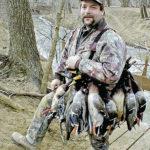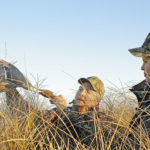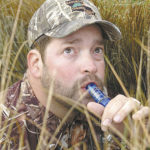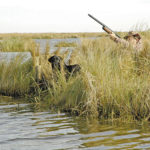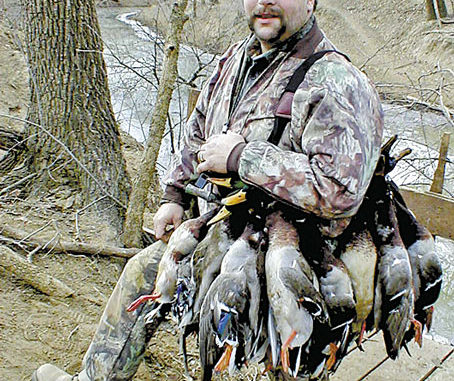
If you hunt now the same way you did in the early season, you’ll return home with an empty bag and a bruised ego.
Ducks don’t talk to each other nearly as much as hunters think, especially during the late season. Just as a roomful of people will migrate away from a loud, obnoxious guy who tries to dominate the conversation, ducks will exhibit the same behavior.
The more you call, the less likely that you’ll attract ducks, especially during January.
Rod Haydel of Haydel Game Calls started going to the duck blind with his dad at the age of 5. Over the last 41 years, he’s hunted webfoots all over the nation, primarily in the marshes around Lake Charles in southern Louisiana.
“During the late season, our ducks in Louisiana are paired up and have started packing their suitcases to return north,” Haydel said. “Remember that from the time the ducks have left Canada, flown down the flyway and been living here in Louisiana, they’ve heard duck hunters blowing duck calls. As soon as you blow your duck call, some of our marsh ducks probably can tell you the name of the call’s manufacturer.
“So you have to call differently at the end of the season than you do at the beginning of the season for success.”
Haydel recommends you use the types of duck calls the ducks don’t hear every morning and afternoon.
“Use pintail whistles, gadwall calls and possibly some blue-winged teal quacks,” he suggested.
The tough duck hunting in Louisiana at this time of year has inspired Haydel, as well as other duck-call manufacturers, to design specialty calls, like gadwall calls and blue-winged teal calls.
“To take more ducks in the late season, call as little as possible, and depend more on your decoy spread and blind than you do on your mastery of duck calls,” he said. “If you try to call too much, not only will you flare the ducks on the day you’re hunting, but you’ll keep them from coming into your blind on upcoming trips.”
Haydel doesn’t have anything against using mallard calls, but the timing of when to use a mallard call and what to say critically impacts success in taking late-season ducks.
As long as the ducks come toward your blind, Haydel says, “Shut up, and don’t call. If the ducks see your decoys, react to them and start to come in to you, don’t call. In January, I rely much more on my decoys than on my calling ability.”
However, that doesn’t mean calls are useless this time of year.
“If the ducks are swimming downwind or coming at an angle to my blind downwind, I’ll wait until just before they get straight downwind and give them one call made up of about seven notes,” Haydel said. “This is a pleading call where I’ll hold the first note of the call longer than the rest, like, ‘KAAAAK KA-KA-KA-KA-KA-KA,’ which is a long note followed by six short notes. Many times this series of calls will get a reaction from late-season ducks, and they’ll turn back to come into my decoys.
“If I see the ducks wobbling a little bit in the air and acting like they want to drift away from the decoys, I may give them one or two single quacks or start calling with a pintail whistle or a gadwall call.
“During January, I’m really stingy with my calls. The gadwall call is usually a group of short, abrupt quacks with a somewhat different sound than mallard quacks. The gadwall quack isn’t as deep and raspy as a mallard call. I describe it as a ‘tat tat tat’ sound rather than a ‘quack quack quack.’ If you listen to gadwalls on the water, they constantly call like that to each other.
“The teal call is more of a screechy, hoarse type of quack that sounds similar to a mallard call, but is given much faster. It’s kind of ‘Tittittititit’ given in rapid succession.
“Remember that the only reason for using a duck call is to get the bird’s attention on the decoys. The decoys pull in the ducks, and the call lets the ducks know to look for the decoys.”
At the first of the season, big decoy spreads will pay off, but at this time of year, leave most of your decoys at home. Generally later in the season, ducks will stay in smaller groups and pair up.
“If I set out eight decoys, I’ll have two hen/drake pairs on the edges of the pond and four decoys as individuals,” Haydel advises.
Haydel hunts small ponds in the marsh where you won’t see big flights of ducks rafted up.
When duck hunting in January, change up the types of decoys you use. Haydel may set out a few mallard decoys or several gadwalls, but he prefers spoonbill decoys in any January spread.
“I like spoonbill decoys because they provide more bright colors in my decoy spread,” he said. “And pintails, teals and even shovelers can see that spoonbill decoy better than some of the other decoys. The patch of white on a spoonbill drake really can attract more pintails than a pintail decoy will.”
Spoonbill decoys will draw in pintails, mallards and other ducks. In January, various kinds of ducks will feed in the same location. Social ducks like mallards will feed with a variety of ducks. Plenty of spoonbills stay in the part of the marsh where Haydel hunts.
Haydel also will use specklebelly goose decoys, but no more than one or two. “Occasionally, we’ll get one or two specklebellies coming through the marsh where we’re hunting, and we want these geese to key in on that decoy,” he said. “I don’t ever use Canada decoys or snow-goose decoys because in the region where we hunt, you may spot snow geese in the air, but rarely will you see them on the water. Also, we have very few Canada geese that visit this region.”
The type of camouflage you wear in the late season also impacts your duck-hunting success. Some marsh hunters wear dark-colored camo. If you’re in a blind that has shadow and shade in it, and you’re wearing dark camo, you may look like a black spot in the middle of that marsh grass.
“I advise people to wear lighter camo in January, because with the shade created by the blind, that light camo will give more of a shadow-and-shade look to the ducks, rather than a black-hole look,” Haydel said. “During the late season, paying attention to detail is critical. Also, I usually brush up my blind a bit more, because if I’ve been hunting out of the same blind all season, that blind has a certain pattern and look to it, and usually that blind will have more holes in it than it had at the first of the season.”
Also, remember to keep your face hidden and in the shady party of the blind. Watching ducks work to a call or decoys makes duck hunting fun. But when sun hits skin, a glint or a glare from your skin may spook the ducks.
From Canada to Louisiana, most duck hunters want a cold, rainy day with a north wind, believing that bad weather from the north will push ducks down into the Louisiana marshes. But Haydel prefers the opposite type of day for late-season duck hunting.
“I want a clear day with plenty of sunshine and a south wind,” he said. “At this time of year, most of the ducks that come down from the North are already here. The ducks in the Lake Charles area raft up often 20 miles out in the Gulf of Mexico. But if we get a south wind, and the Gulf gets rough, the ducks don’t like to sit out in those high waves with that rough water. So the south wind and the warm weather tend to push the ducks back into the marsh.
“Also, most of the duck seasons in northern states have ended by January, so the ducks don’t have any hunting pressure to push them down to us. Unless there’s a terrible freeze that pushes the ducks out, most of those northern birds will stay up north. In the late season, we’re hunting those same ducks we’ve been hunting since the first of the season. These ducks are the ones that can tell you the manufacturer of any duck call you blow.”
To have good duck hunting in the late season, Haydel prefers a wind change about every two to three days. During a week of the same wind and weather patterns, the ducks will find places where they can feed, loaf, roost and avoid hunting pressure.
“We like weather that ‘stirs the pot,’ as we call it,” Haydel said. “When the wind comes from several different directions over the course of three or four days, the ducks will move. That movement of ducks really seems to help put more ducks in front of your blind each day.”
Last-ditch tactics for ducks
When duck hunting at the end of the season, you have to change techniques often or you won’t get any ducks. According to Haydel, you may want to:
- Fill your boat almost all the way up with grass, position it 60 to 70 yards downwind of the decoys and then try to shoot past the ducks as they circle to come into the decoys. Don’t over-call the ducks. Just let the decoys do the work, and take the birds when they’re within range. This method will work in the late season when you’re hunting smart ducks.
- Change the rhythm and the cadence of your calling too. These ducks more than likely have flown over your decoys before, and they’re smart enough to know that the same hen mallard doesn’t sing the same song in the same place every day of duck season.
- Take your decoys in every day and put them out every morning. This way, your decoy spread always looks different, and ducks won’t get accustomed to seeing the same decoys in the same place each day.
- Use coot decoys. If you’ll notice ducks on the water, you’ll see that they often will stay near coots, and rarely will you see coots where you see duck hunters. Therefore, I’ve learned that using coot decoys with my duck decoys gives the ducks another look at something a little different and more natural than the average decoy spread.
If you continue to do what you’ve always done, you can expect to have less success in the late season than you have in the early season. The ducks and the weather have changed.
